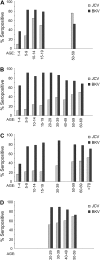Pathogenesis of progressive multifocal leukoencephalopathy--revisited
- PMID: 21227915
- PMCID: PMC3072716
- DOI: 10.1093/infdis/jiq097
Pathogenesis of progressive multifocal leukoencephalopathy--revisited
Abstract
Progressive multifocal leukoencephalopathy (PML) is a demyelinating disease of the central nervous system that is rare even though the proven etiological agent of PML, the polyomavirus JC (JC virus), is ubiquitous within the human population. The common feature of PML cases appears to be underlying immunosuppression, and PML has gained clinical visibility because of its association with human immunodeficiency virus and AIDS and its occurrence as a side effect of certain immunomodulatory drugs. A hypothesis has gained general acceptance that JC virus causes a primary infection in childhood and enters a latent state, after which immunosuppression allows viral reactivation leading to PML. Nonetheless, many important aspects of PML pathogenesis remain unclear, including the molecular bases of latency and reactivation, the site(s) of latency, the relationship of archetype and prototype virus and the mode of virus transmission within the body and between individuals. In this review, we will revisit these areas and examine what the available evidence suggests.
Figures


References
-
- Åström KE, Mancall EL, Richardson EP. Progressive multifocal encephalopathy: a hitherto unrecognized complication of chronic lymphocytic leukemia and lymphoma. Brain. 1958;81:99–111. - PubMed
-
- Schwerdt PR, Schwerdt CE, Silverman L, Rubinstein LJ. Virions associated with progressive multifocal leukoencephalopathy. Virology. 1966;29:511–4. - PubMed
-
- Silverman L, Rubinstein LJ. Electron microscopic observations on a case of progressive multifocal leukoencephalopathy. Acta Neuropathologica. 1965;5:215–24. - PubMed
-
- ZuRhein GM. Polyoma-like virions in a human demyelinating disease. Acta Neuropathol. 1967;8:57–68. - PubMed
-
- ZuRhein GM, Chow SM. Particles resembling papovavirions in human cerebral demyelinating disease. Science. 1965;148:1477–9. - PubMed
Publication types
MeSH terms
Substances
LinkOut - more resources
Full Text Sources
Other Literature Sources

